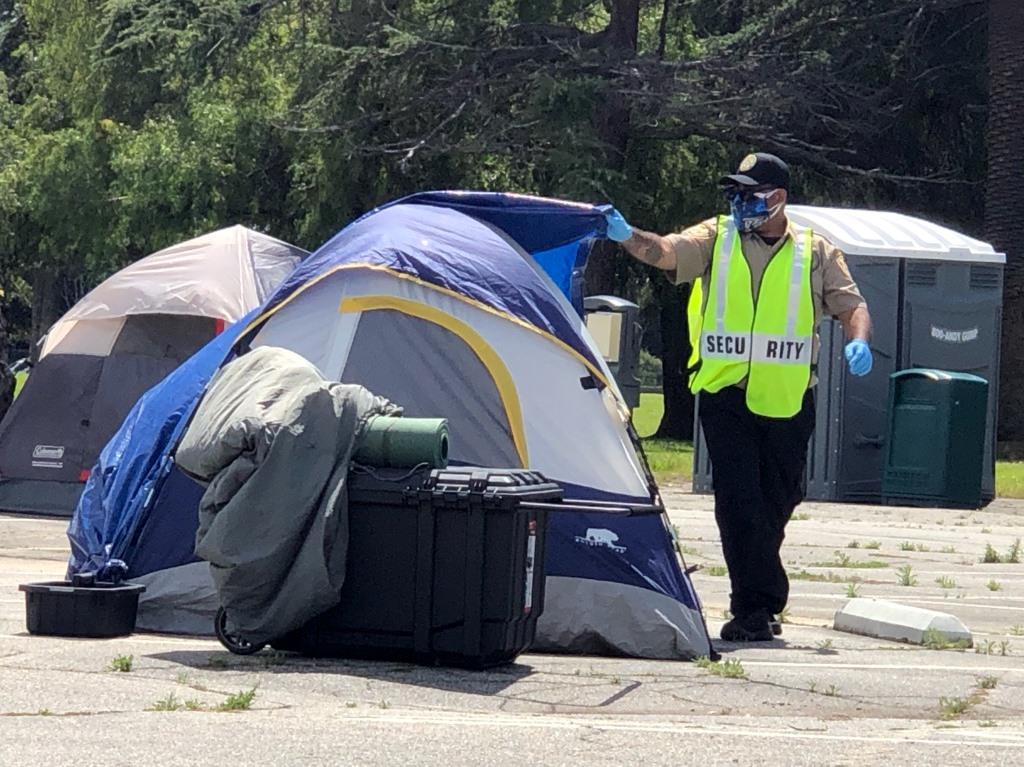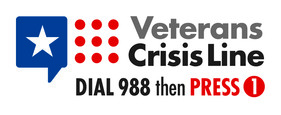
A Veterans Administration security guard places a tarp over a tent provided to a homeless veteran on the West L.A. VA grounds. (Photo: Los Angeles VA)
Last month, we posted an opinion piece about the tents recently set up for homeless veterans inside and outside of the fenceline of the Los Angeles VA. The article was written by veteran Robert Rosebrock, a longtime advocate for homeless vets who has consistently butted heads with other advocates over how to best treat the homeless problem in Los Angeles. He wrote some incendiary things about the VA and how it was treating homeless veterans, particularly in reference to the tents set up on VA grounds for homeless vets to use during the COVID-19 crisis.
We posed many of Rosebrock’s points via email to Robert McKenrick, executive director of Community Engagement and Reintegration Service (CERS) and Master Plan for the VA Greater Los Angeles Healthcare System.
Q: What was the process by which veterans were chosen to be given tents?
A: Healthcare eligible veterans – that is, veterans who meet the statutory and regulatory requirements to receive VA healthcare benefits — either approach the CTRS (Care, Treatment and Rehabilitation Services) service on their own or are referred by VA and community providers. The veterans are screened to be sure that this is the best service for them given their current needs and desires. This process is generally completed through our Welcome Center, which has been active on the West L.A. VA Campus for several years and is well-known to homeless veterans throughout the L.A. area.
Q: What are the conditions the veterans have to agree to in order to remain in the tents?
A: We have set the rules and conditions for CTRS based on the need to balance respect for individual veterans’ autonomy with public health concerns. Given what we know about the COVID-19 virus, we must require that veterans comply with public health and infection prevention protocols through social distancing, frequent hand-washing, and good-hygiene behaviors.
Q: How long will the tents be provided?
A: Veterans can keep the tents that were donated to GLA and provided to them. During their stay, we clinically engage with each veteran, working toward a permanent housing solution. We will continue to assess the ongoing need for the use of tents on the VA campus as the pandemic evolves.
Q: Is it true that veterans living outside the VA fence aren’t allowed to use the portable bathroom and shower facilities on the grounds? If so, why?
A: Yes, but there are specific public-health reasons for that rule. The bathrooms have been provided specifically for veterans in CTRS, cleaning services and bathroom locations have been designated to reduce infection risk, maintain CTRS participants’ safety, and ensure adequate resources for the service. Veterans in CTRS are screened for possible COVID infection and maintain social distancing, to include using specific bathrooms in the vicinity of their tent, to minimize additional exposure. We could not maintain safety if we allowed unscreened, unenrolled veterans or others to use the facilities.
Q: Why is security posted near the tents?
A: The West L.A. VA Campus has on-site security just like any other VA healthcare facility or large urban hospital. Security staff are located in CTRS to maintain the safety of CTRS participants and to be able to provide an initial response to any situation. Providing a safe environment is essential to getting many homeless veterans to come into the hospital.
Q: Does the VA intend on improving the conditions of the homeless encampment on the West Los Angeles VA? Or are the conditions adequate? Robert Rosebrock is calling the tent accommodations “nothing shy of an internment camp.” I imagine the VA disagrees with this statement.
A: That characterization doesn’t square with the facts. CTRS participation is completely voluntary and CTRS rules are to protect the health and well-being of veterans. And while of course VA will work to improve CTRS over time, VA does not consider the current conditions inadequate.
VA has traditionally offered a continuum of services for homeless veterans, including clinical, treatment, and rehabilitative services as well as emergency, temporary, and permanent housing. Most veterans avail themselves of some but not all of the available services. CTRS adds another option to the traditional continuum but is not a required step along any homeless veteran’s journey to permanent housing.
As explained above, the COVID-19 pandemic requires VA to impose social distancing and hygiene-related requirements within CTRS, as in other residential programs and services on the VA Campus. Those requirements help to protect the participants from infection.
Whether a veteran chooses to opt in or out of CTRS, VA staff continue to work actively to get the veteran permanently housed and cared for.
Q: Did the VA reject Rosebrock’s offer to provide 10×14 walk-in tents with cots, as he claims? If so, why?
A: VA appreciates and actively seeks collaborative efforts with our community partners, and it is thanks to these efforts that we have food services, supplies, and hygiene resources for our veterans, as we work to engage and provide the clinical care that will pave the way to our veterans remaining housed in their own safe residence in the future. Input from many of our community stakeholders, including Mr. Rosebrock, led to the establishment of CTRS as part of our COVID-19 response, but clinical and public health indicators necessarily drove our decisions about the size and configuration of the tents and the social-distancing and hygiene rules participants must follow to keep themselves and others safe. We provided a square-foot limitation of the tents that would work within the limits of CTRS to control social distancing and program oversight within the space set aside for the program.












